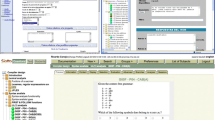Abstract
On-line Web-based learning environments with automated feedback, such as WebLearn [5], present subject questions to the student and evaluate their answers to provide formative and summative assessment. With these tools, formative learning activities such as quizzes and tests are mostly pre-planned, since testing instruments are generated by selecting questions in a pre-specified manner out of question banks created for the purpose. Although this approach has been used with a significant degree of success, the real challenge to support students’ learning is to mimic what a human instructor would do when teaching: provide guided learning.
The main difficulty associated with creating such an ’electronic tutor’ is to implement the required intelligent dynamic behaviour during learning. That is, at any stage of a student’s learning session the system should take into account his/her demonstrated cognitive level to generate the next appropriate formative testing instrument. For students to be able to make the higher-level cognitive contributions as they progress through a session, the system must keep a history of students’ answers and must react accordingly. We call here that behaviour adaptive learning by adaptive formative assessment.
We propose on this paper a strategy to implement an adaptive automated learning system, based on establishing an incremental cognitive path from the lowest to the highest level questions related to a concept. In the research literature this has been often called ’cognitive scaffolding’. For our on-line automated environment, the first hurdle has been how to define the scaffolding and how to implement it from question banks that have not been created for this process. Our approach is embodied in WebTutor, a ’black box’ component being developed at RMIT University to work in combination with the generation, presentation and feedback capabilities of the WebLearn system.
Access this chapter
Tax calculation will be finalised at checkout
Purchases are for personal use only
Preview
Unable to display preview. Download preview PDF.
Similar content being viewed by others
References
Baker, F.: The Basics of Item Response Theory. In: Boston, C., Rudner, L. (eds.) ERIC Clearinghouse on Assessment and Evaluation, 2nd edn., USA, ISBN 1-886047-03-0
Bloom, B.S.: Taxonomy of Educational Objectives. David McKay Company Inc., New York (1964)
Chalmers, D., Fuller, A.: Teaching for Learning at University: Theory and Practice. Edith Cowan University, Perth. (1995)
Doran, M., Langan, D.: A Cognitive-Based Approach to Introductory Computer Science Courses: Lessons Learned. SIGCSE Bulletin. In: Proceedings of the 26th ACM SIGCSE Technical Symposium, Nashville, TN, March 1995, pp. 218–222 (1995)
Fernandez, G.: WebLearn: A CGI-Based Environment for Interactive Learning. Journal of Interactive Learning Research 12(2), 265–280 (2001)
John, S., Netherwood, G.: Learning Taxonomy Analyses Of Student-Based Activities Using The Lego Mindstorms System. In: Proceedings of the 13thAAEE Conference, Canberra, ACT, Australia (September 2002)
Fernandez, G., John, S., Netherwood, G.: Objective-Based Teaching of Science and Engineering With an On-line Student-Centred Environment. In: Proceedings of the 12th AAEE Conference, QUT, Brisbane, Australia, pp. 332–337 (2001)
Laurillard, D.: Rethinking University Teaching: A Framework for the Effective Use of Educational Technology. Routledge, London (1993)
Prosser, M., Trigwell, K.: Teaching for Learning in Higher Education. Open University Press, Buckingham (1998)
Wood, D., Bruner, J.S., Ross, G.: The role of tutoring in problem solving. Journal of Child Psychology and Psychiatry 17, 98–100 (1976)
Author information
Authors and Affiliations
Editor information
Editors and Affiliations
Rights and permissions
Copyright information
© 2003 Springer-Verlag Berlin Heidelberg
About this paper
Cite this paper
Fernandez, G. (2003). Cognitive Scaffolding for a Web-Based Adaptive Learning Environment. In: Zhou, W., Nicholson, P., Corbitt, B., Fong, J. (eds) Advances in Web-Based Learning - ICWL 2003. ICWL 2003. Lecture Notes in Computer Science, vol 2783. Springer, Berlin, Heidelberg. https://doi.org/10.1007/978-3-540-45200-3_2
Download citation
DOI: https://doi.org/10.1007/978-3-540-45200-3_2
Publisher Name: Springer, Berlin, Heidelberg
Print ISBN: 978-3-540-40772-0
Online ISBN: 978-3-540-45200-3
eBook Packages: Springer Book Archive




